VTX 1300 Desmog
Posted by Bare | Last Updated April 6, 2016This is a walk-through for removing the PAIR valve assembly, and all the hoses and junk that are associated with it, on the VTX 1300 49 state model. I have never dealt with a CA model (living in Louisiana) so if anyone wants to take good quality pics, write a description and email it all to me I’ll be glad to add that information.
For those who wonder how much stuff is under the tank that doesn’t need to be, here’s what gets removed:
Lotsa junk eh? There’s even more on the 1800 model!
I’ll let Biglry sum up the mod since he wrote the book on it originally:
Ever heard of any one changing header pipes, they go cheap and use the old gaskets then get popping on decel from sucking in cold air at the exhaust port? Well I have seen by doing this mod 99% of decel popping stops on a stock bike. Could it be because no fresh air is going in the exhaust port? I feel that it is why we see this decel popping on a lot of stock VTXs.
I would like to clarify a few other points. Nowhere in my "how to" post did I say these mods were needed for the VTX or said any thing about RWHP gain or possible warranty problems. I tried to give a straight forward way to do this mod as there is a lot of myth and misconception that has arisen over these federally regulated emission parts of the VTX. In no way do I advocate anyone to break Federal emissions laws or state emissions laws 😉 and as Docc has said I know of NO Honda dealer that would violate Federal emissions laws (it’s a big $ fine). The fact is without these Federal mandated and state regulated laws, Honda probably would not have put a PAIR system or EVAP canister, catalytic muffler, O2 sensor or any of the other emission specs on the VTX. The emissions equipment on my VTX is of no benefit to it’s rideablity and makes no RWHP gains that I have found.”
BIGLRY Out 🙂
As always undertake this project at your own risk. I have detailed this write-up for the C model but the procedure is the same for all 49 state 1300 VTX’s.
The original version of this mod recommended capping off the reed valves using rubber caps but over time I’ve found that these caps dry up and crack leaving you with unfiltered air getting into your motor and the need to refix the same problem every few months. In updating the mod here I recommend using block-off plates to alleviate this issue. You can buy these plates from DLP or Biglry & Bone’s which do not require dismantling the reed valve gasket plate. The plates are inexpensive, look a lot nicer than caps and last forever.
This project takes most people between 1-2 hours the first time, YMMV.
Testing
For anyone that is interested in this mod but are afraid of what the end results will be you can test it out beforehand. Look inside the airbox under the air filter and you will see 2 small holes above the 10mm mounting bolt. The crankcase breather is the lower one and the PAIR inlet is the top one (see pic to right). You can plug the PAIR inlet with a rubber plug, I’m unsure exactly which size is best. We use a #000 plug on the 1800’s, it’s available at most hardware stores for less than a quarter. You can smear a little RTV silicone on the plug if you want to ensure a complete seal.
If you don’t want to use the rubber plug you can use just about any creative method of plugging this hole you can come up with, as long as the plug is solid and has no chance of being sucked up the hose. I’ve heard of guys removing the hose from the back of the airbox and plugging it with a large bolt, a marble, etc – whatever works for you. The only thing you need to be absolutely certain of is that you DO NOT plug the crankcase breather!
Now some of you may ask, why not just plug this instead of doing the entire mod?
This is an excerpt from VTX-Rated:
In addition to the smoke problem, as condensation builds in these hoses it can cause an annoying "gurgling" sound. Over time the PAIR valve will eventually stick open allowing air to move from one reed valve to the other through the accumulated condensation. Bottom line, it’s best to do the entire removal if you decide that you would like to keep the system inactive.
Required tools/Materials
- Tools to remove seat
- Tools to remove gas tank
- 10mm and 8mm (or 5/16″) wrench
- 10mm socket
- 5mm allen
- Ratchet & extension
- Flathead screwdriver
- #2 philips screwdriver
- Small needle nose pliers
- RTV silicone (high temp variety)
- Block-off plates from DLP or Biglry & Bone’s
If you still have the stock airbox you’ll need:
- A good #2 philips screwdriver, possibly an impact driver (for removing stock airbox)
- One 1/2″ rubber vacuum cap (available at most good auto stores)
|
Process With those out of the way, remove the stock airbox cover and filter using the 5mm allen. Don’t lose the 5 plastic washers that are behind these screws as Honda gets $2 a piece for them. Make sure that the big rubber gasket that the air box cover seals against stays put, if it comes out just use a small screwdriver to carefully push it back in place. |
|
With a good phillips screwdriver remove the 3 screws that hold on the air box. If they do not come right out then use the impact driver rather than strip the screws. Be careful when you hit the driver, you just need a little tap with a hammer and the driver does all the work. Also remove the 10mm bolt at the bottom of the airbox. With that done you’ll see the airbox being held to the bike’s backbone by a small metal tab. Carefully press the airbox down until you can get the tab out of the rubber grommet it is in, at this point you can lean the airbox away from the bike and you will see 2 hoses and the idle adjustment knob attached to the back of the airbox. The big hose is the PAIR inlet, the small hose is the crankcase breather. Reach behind the airbox and pull off both hoses and the idle adjustment knob (it just snaps on). With these disconnected you should be able to get the airbox off the bike altogether. |
|
Grab the airbox and the 1/2" vacuum cap and cap the inlet where the PAIR hose (the large hose) went into the airbox. Biglry used to recommend 3/8" caps but many (including myself) found that these were nearly impossible to get on and would usually split in the process. The 1/2" caps work great. To ensure a good seal use a little RTV silicone in the cap, it helps with sliding the cap on and when it cures it will make a perfect seal. As you can see in the pic I use a zip tie to hold the cap in place, this gives the RTV a little time to cure while I do the rest of the work. You can also use a hose clamp if you don’t have a zip tie handy. Looking at the back of the airbox you can also see the smaller nipple the small hose hooks to, this is the crank case breather, do not cap this line! It must be left open to vent the crank case. You will put this hose back on when you put the air box back on. If you cap, pinch or kink this line so it cannot vent when the bike is running you will blow the seals on your transmission and make quite a mess spraying oil around. |
|
Now look at the backbone of the bike and you will see a 10mm bolt holding the PAIR solenoid valve in place. There are 4 hoses coming from the PAIR valve. Trace these 4 hoses, one is the big hose that plugged into the back of the airbox, one is a vacuum line, and the other 2 go to the reed valves on top of the motor (one in front, one in back). Unplug the vacuum hose from the PAIR valve and trace the other hoses and remove them from the reed valves. After awhile the hoses stick on there pretty well, but a little twist will help get them off. The front is held on with a simple spring clamp, the rear is held on with hose clamps (see pics below). It’s easiest to remove both hose clamps and leave the short section of rubber hose on the reed valve. |
| Front cylinder |
|
Rear cylinder |
With the 4 hoses undone you can remove the 10mm bolt on the backbone of the bike and remove the entire PAIR valve assembly.
With that junk out of the way it’s time to remove the reed valves and replace them with block-off plates. Find the reed valve covers on the front and back cylinder (see pics above) and take an 8mm (or 5/16") wrench and remove the bolts that hold the reed valves in place. If you have a 1/4" drive ratchet with an 8mm or 5/16" socket you can use that instead of a wrench and it will make this task a little easier. These bolts are in a tight space, so I know it can be tough – just be patient and you’ll get it. It will require a lot of small turns to get it loose but eventually you’ll be able to spin them out with your fingers.
With all the bolts out you can remove the reed valve covers and then reach in to pull out the gasket plate assemblies.
Unless you are using Biglry’s plates you’ll need to disassemble the gasket plate assemblies to get just the gasket plates by themselves. If you don’t disassemble them then the screw that holds them together will prevent the plates from making an airtight seal. This will give you a bad air leak, horrible clatter with the motor running, decel popping like crazy, and unfiltered air entering the motor. If you are using Biglry’s plates then click here to jump past this section.
The screw (#1) is what holds it all together but it is flared on the end so you can’t just unscrew it. You can take a grinder or dremel tool and grind the flare off and then unscrew it, but if you slip and nick the gasket you’ll have a leak. You can also take a pair of pliers and pull off the #2 and #3 plates. You can bend them, they will snap off and the screw will come out as well. It destroys the #2 and #3 plates but you’re not reinstalling them anyway and it’s much faster than hassling with the screws. I do want to offer a word of warning since it was mentioned to me by one rider… He broke the gasket plate itself in half when trying to remove parts #2 and #3 from #4. First, be careful – it doesn’t take a lot of force just a good pair of pliers and a few times bending and "rocking" the metal back and forth to snap it off. If you do have the misfortune of breaking a plate, don’t panic! You can use a small dab of JB Weld CAREFULLY applied to put it back together and use some high temp RTV to seal the block-off plate. To be honest, if you use the high temp RTV you don’t need the gasket plate at all, but I like to keep it in for good measure (between the gasket and the RTV you have 2 seals so you’re sure not to get any leaks).
With all that said, the safest and surest way to do this without breaking anything is to drill the screw head off using (roughly) a 7/64″ drill bit. With the screw head gone the entire thing just falls apart.
Now drop the gasket plates back in the reed holes on the motor where they came from and install the block-off plates on top of them. I like to put a small bead of RTV silicone (high temp variety) on the plates before putting them on. I don’t think it’s totally necessary, but it only takes a moment and helps ensure a good seal. Use the same 8mm bolts that held the reed valves in place when bolting down the block-off plates. There is no specific torque spec for these bolts in the manual but trust me, they are small enough that you don’t have to really “wrench” them down tight. Get them snug and you can leave them alone.
You can see the finished product in these pics:
| Front cylinder |
|
Rear cylinder |
With both block-off plates finished the last step is tying up the loose end of the vacuum hose you removed from the PAIR valve. Trace the vacuum hose under the backbone and you’ll find where it ties into the other vacuum lines with a “T” fitting. Trace the hoses to both sides of that “T”, to the left you’ll find another “T” near the petcock and to the right you’ll find the hose attached to the carb (see right pic below).
With a small pair of pliers (needle nose work well) loosen the clamp on the hose at the carb and remove the vacuum hose from the carb. Pull this hose to the left side of the bike and then disconnect this entire bit (3 hoses and 1 “T” fitting) from the remaining “T” fitting which goes to the petcock. You should then have in your hand what you see in the left picture below.
Now remove the long hose from the “T” (this is the bottom hose in the pic) that used to run to the PAIR valve. Set aside the remaining 2 short hoses and “T” fitting, you don’t need them anymore. You’re going to use this one long piece of vacuum hose to reconnect the carb to the “T” near the petcock (you’re using this piece to replace the connection that used to have the “T” in the middle). Make sure and take the small clamp from the original carb hose and reuse it when connecting to the carb again.
That’s all there is to it, now everything just needs to be put back together.
Reassembly
Reinstall the airbox in reverse order, make sure to plug the crankcase breather back in and attach the idle adjustment knob. Make sure that the 1/2" vacuum cap you just installed is in place over where the PAIR hose used to plug in. Carefully slide the metal tab at the top of the airbox back into it’s rubber grommet on the bike’s backbone and then use a good phillips head screwdriver to reinstall the 3 screws to the carb nice and snug – DO NOT use the impact driver to reinstall them. Don’t forget to reinstall the 10mm bolt at the bottom of the airbox and then reinstall the filter and the cover with the five 5mm bolts making sure that you don’t lose the 5 plastic washers on the screws in the process.
With the airbox back in place reinstall the gas tank and reinstall the seat by following the directions in reverse.
That’s it – you’re done – congratulations!
Afterthoughts
This is an inexpensive mod that helps cut down on about 95% of the decel popping this bike exhibits when stock. It will help stop the “blatty” sound you hear when you first start the bike when it’s cold and it will make your exhaust note a little deeper. It will not have ANY affect on the performance of the bike and doing it requires no additional “mapping” changes to your fuel manager. Some have argued that removing the smog system from the bike may aid exhaust scavenging when using a 2-into-1 or a 2-into-2 exhaust with a crossover. While this is likely true (the smog system would tend to cancel out scavenging effects) the results would be, in my opinion, very minimal and not worth mentioning.
A lot of people ask about the warranty aspect of doing this mod. The bottom line is that it will depend on your dealer and how much of a hassle they want to be. Technically they cannot refuse you warranty service based on this mod, but some will because some dealers are a pain in the ass. So they may give you grief over it, but if you call Honda of America (bypassing the dealer) they should make them honor the warranty.
The legal side of this is the Magnuson-Moss Warranty Act which is vehicle warranty law – US Code – Title 15, Chapter 50, Sections 2301-2312 state "Legally, a vehicle manufacturer cannot void the warranty on a vehicle due to an aftermarket part unless they can prove that the aftermarket part caused or contributed to the failure in the vehicle." This means, very plainly, that if a dealer tries to void your warranty based on any modification to a vehicle then they have to prove (THEY have to prove, not you!) that the problem you’re having was caused by the modification you made. Since the desmog (when done properly) cannot cause any problems on the bike they would then be forced to honor the warranty.
If a dealer fails to honor your warranty you can contact the FTC at (202)326-3128 or www.ftc.gov.

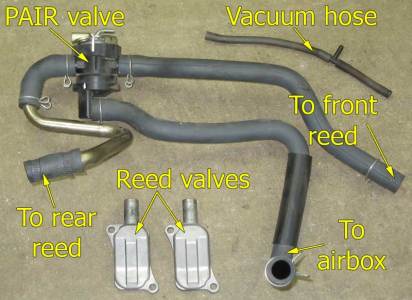
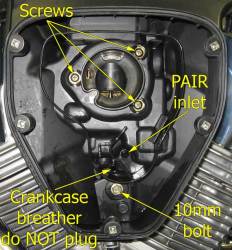
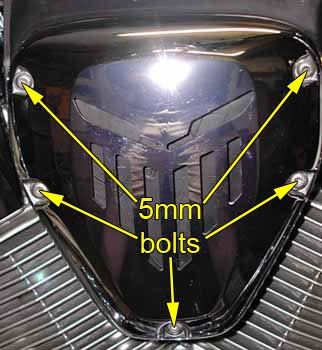
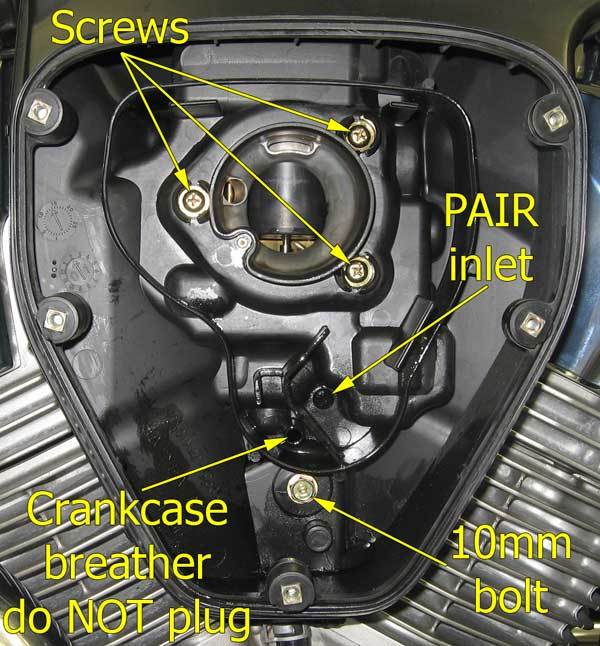
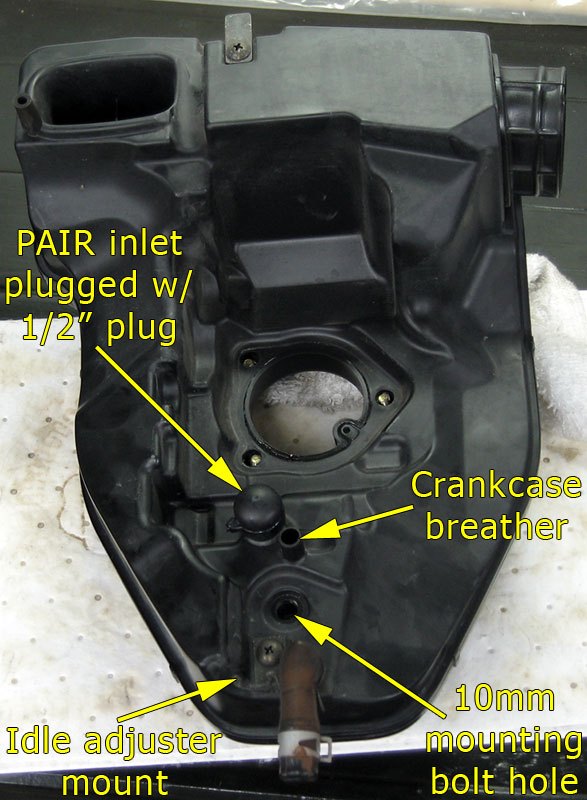
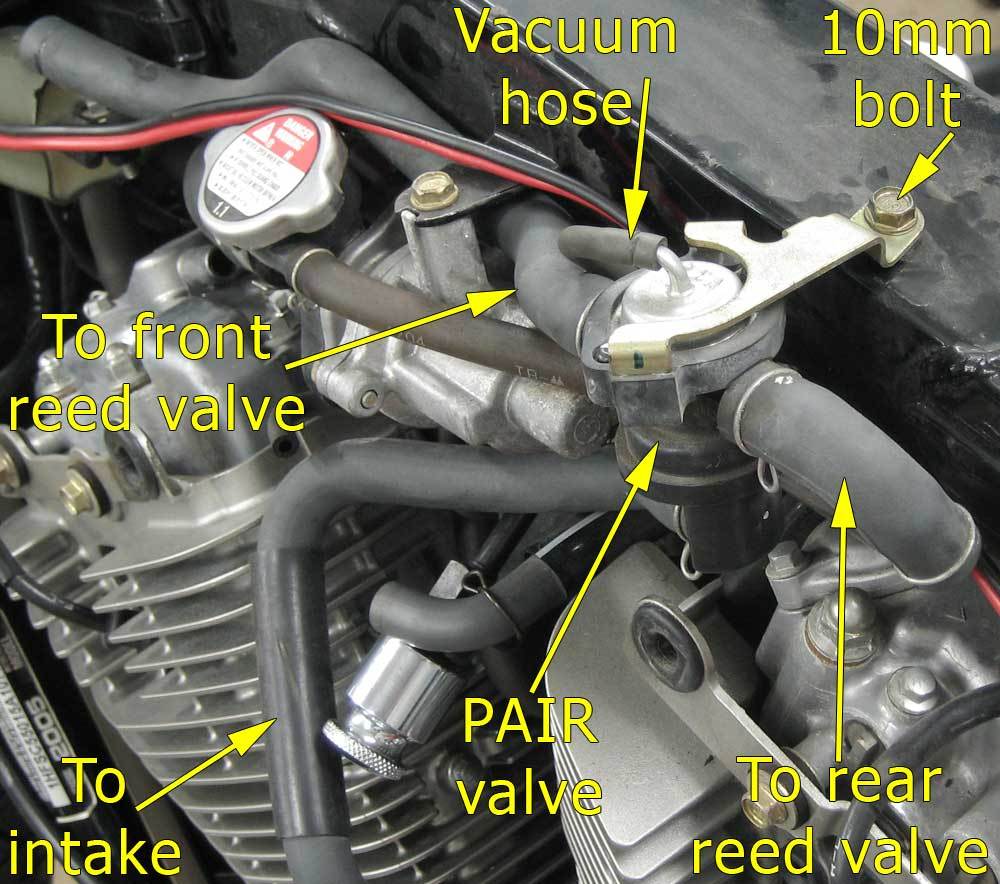
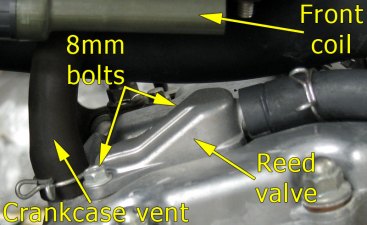
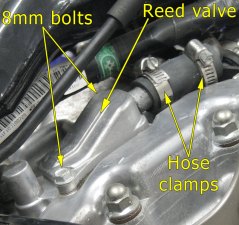
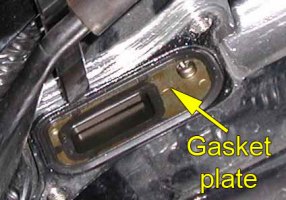
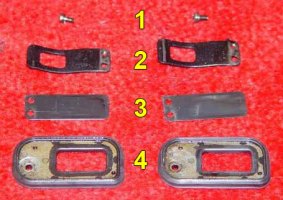
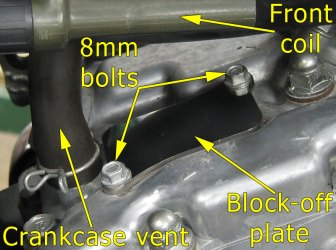
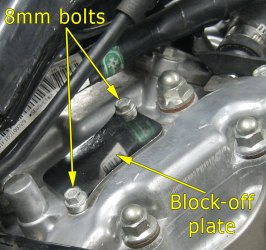
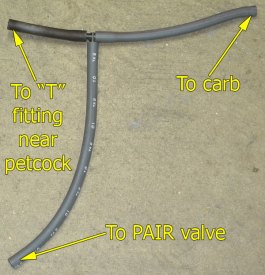
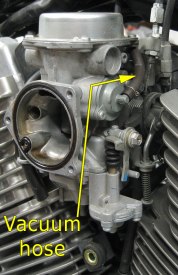
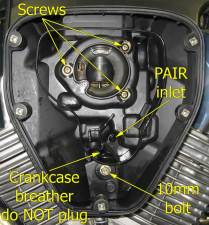
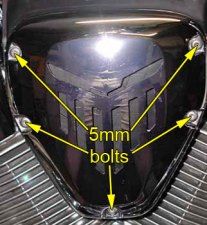
Great write up! Very clear and easy instructions to follow. This mod got rid of that horrible gargling noise from my exhaust. I would recommend you definitely use a 1/2″ plug on the air box instead of fighting with the 3/8″.
Just done the pair valve job to my bike my new
Pipes were popping afterwards no more
Popping same power sounds awesome live it
Thank u big time just need to check my mileage
Great tech help guys! Did the pair valve removal and block-off plate install in about an hour and a half with the help from your site. It’s like having a brand new bike! Great pics and tips! Keep up the good work!
Just put on the plates i ordered and used this write up to reference. Thanks alot! I dont think there is another out there so plain and easy to follow. Of coarse when i bought the block off plates i tried to just take the valves off and put the plates on. Once seeing that wasn’t going to work I fond your article which showed step by step what to do. After following these steps my straight pipes have never sounded so better and have not popped one time, thanks!!
Wonderful tech sheet. Very detailed and easy to follow. Job completed in about 2 hrs at a leisurely pace. Thank you very much!
Perfect instructions. Worked like a charm without any issue. Thanks for taking the time to post all of this effort. It took me abut 2.5 hours mostly because I was over cautious and meticulous with every step. The end result was just like I expected. About 95% of the backfiring is gone. I will definitely send anyone I know to this website for these details when they need it done. Thanks again.
I have put up a quick writeup on vtxoa and the cafe about removing the CA emissions if you wanted to include it here.
Just wanted say great instructions everything went like clock work bike runs great. I didn’t wait to order the block off plates and I used boat plugs from my 2 man bass buster can’t remember what size but they fit perfect in reed valve pipe I live in Louisiana also and thats what you call coon ass rigging but thanks for the mod.
These instructions are second to none…..What a huge help! Less than 30 mins from start to finish. I was able to find the block off plates at VTX-Parts.com (18.50 w/ dimples delivered for the pair). Thanks for the instructions!!
Awesome instructions. I started on my own without them and then couldn’t figure out how to deal with the rubber vacuum lines. Did a search. Found you and my life was saved. Excellent clarity and photos.
Sent from the GWN.
Ordered plates w/dimple from VTX-parts.com (Leo) and paid for them 9/2014. Never got them. Leo doesn’t answer his email. Anyone know what happened to him please email me.
I ordered plates from him on 9/22 and received them on 10/6.
Just used this page to do the desmog mog and all i can say is Thanks! Very easy to follow!
Cincinnati Ohio 07 1300c
Thank you for the desmog information! It’s exceptionally easy!
I can now vouch for the condensation problem that was mentioned. The PO of my 05 VTX1300C put a hypercharger on and just capped the large hose that was connected to the air box; when I pulled the PAIR system, I found that the entire lower hose was FULL of water!
Great info! Thanks again for the writeup!
I did this mod on my 2006 VTX 1300C today July 16, 2015. I used a large vacuum cap put into the hole backwards and sealed with black RTV to Seal around the edge and encourage the plug to stay in. It fit pretty tight in the first place so I am not anticipating any problems. I bought this bike a couple of weeks ago and have had back firing through the Vance & Hines pipes and a really fast idle when I first got it which reappeared just before I did this mod. I believe the Fast Idle is a Fuel problem, being that this is an 06 with just over 1300 miles on it. So consequently it has sat most of its life. The first time I did the carb I Dumped the fuel from the tank and put in fresh fuel I am going to do another Fuel Dump and go get fresh fuel to put back in it.
Just finished this mod with the help of these crystal-clear instructions. I would have been lost without them. Very well done and easy to understand, the pictures are perfect, also.
Started the bike and thought it was someone elses at first-no popping anymore!
Thanks for the great help you provided.
Hey I did a couple things different on mine and took pictures to share with you if you’re interested. You can feel free to e-mail me at the provided address. Thanks
Just did this mod to my 03 1300s. Easy and smooth. The only thing different on mine was that there was only 1 “t” in the vacuum lines. No peacock vacuum line. I removed the T and ran the line straight from the carb to the source fitting. I had to cut about 3/4 of an inch off of the line so it wouldn’t kink. Thanks again for the write up.
Hi Tugg. I plan to remove the PAIR valves from my 2003 Honda VTX 1300. It also has no peacock vacuum line. You mention that you ran the vacuum line from the carb to the source fitting. I can’t figure that out. If you could kindly provide some detail as to it’s location etc. Any assistance in this matter will be greatly appreciated . Thanks and be save. David.
Awesome writeup! So simple and helpful with these instructions, everything went like butter. The dimples in the plates are worth investing in, especially as its a couple dollars more at most.
Thanks for the right up. I replaced my air cleaner, with a Baron Big air Kit that came with the reed valve block off plates, nice set up. Anyway the instructions with the kit were no where near as good as yours. they would of had me just plug the tubing and didn’t mention anything about pulling the pair valve. Thanks again for publishing this.
2 tees left over for cali bikes. 1 up to the evap system. I tried to remove the evap system on my 1300 and failed. Ran horrible cruising around 60. Put it all back but pair valve removal went well.
[…] what you need to know for removing that PAIR system… https://tech.bareasschoppers.com/engine/vtx-1300-desmog/ […]
[…] Do not plug the hose, it will fill up with condensation. Remove it, plug the cap at the engine or just buy the $15 plates. […]
Total new bee to working on my own bike. Just finished this mod and you made it so easy. Thank you this helped so much.
Thanks for the tips – I made sheet metal block plates and placed them under the stock part. It was about 75 cents of sheet aluminum (flashing). Removed all the PAIR hoses and main valve. Your tip about reusing that section of vacuum hose was great! I did the work today because I had to check the valve clearances (scheduled maintenance.) I haven’t started it yet but expect no issues based on what I have been reading. Thanks again!
Day 2 – after desmog’ing my VTX 1300c I definitely noticed the deeper exhaust tone. I have Cobra slash-down pipes. Noticed no decel or low-speed popping which is nice, especially when cruising through small towns at 25 to 35 mph
Additional note – my bike has 25,600 miles. When I removed the PAIR system it was full of gunk. If someone chooses to keep the PAIR system, it probably needs some regular maintenance. Looking at where it sucks it’s air from in the stock air filter box, I was not surprised to see all the gunk. The intake hose is close to the crankcase breather outlet. Next maintenance I plan to do is to disassemble the crankcase breather hoses and clean them.
I was looking at buying a new bike but new bikes are too expensive. Besides, I like wrenching on my 2004 carbureted vtx1300c.
I have started the process of desomg my son 2007 1300c it is from California. There is the canister in front of the rear tire does that get removed on 1300? I saw that it is removed on my 1800 Help please,
I plan to remove the PAIR valves from my 2003 Honda VTX 1300. It has no peacock vacuum line. If you could provide some details as to the new route of the vacuum line from the carburettor. Any assistance in this will be greatly appreciated .Thanks.
Where does the vacuum line on the carb go